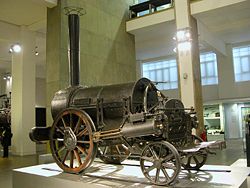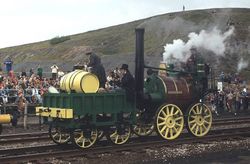Rainhill Trials
2008/9 Schools Wikipedia Selection. Related subjects: Railway transport
The Rainhill Trials were an important competition in the early days of steam locomotive railways, run in October of 1829 in Rainhill, Merseyside (between Liverpool and Manchester).
When the Liverpool and Manchester Railway was approaching completion, the directors of the railway ran a competition to decide whether stationary steam engines or locomotives would be used to pull the trains. The Rainhill Trials were arranged as an open contest that would let them see all the locomotive candidates in action, with the choice to follow. Regardless of whether or not locomotives were settled upon, a prize of £500 was offered to the winner of the trials. Three notable figures from the early days of locomotive engineering were selected as judges: John Kennedy, John Urpeth Rastrick, and Nicholas Wood.
Rules
Locomotives that were entered were to be subjected to a variety of tests and conditions. These were amended at various points, but were eventually nailed down to:
- "The weight of the locomotive engine, with its full complement of water in the boiler, shall be ascertained at the weighing machine, by eight o'clock in the morning, and the load assigned to it shall be three times the weight thereof. The water in the boiler shall be cold, and there shall be no fuel in the fire-place. As much fuel shall be weighed, and as much water shall be measured and delivered into the tender-carriage, as the owner of the engine may consider sufficient for the supply of the engine for a journey of 35 mile [56 km]. The fire in the boiler shall then be lighted and the quantity of fuel consumed for getting up the steam shall be determined, and the time noted.
- "The tender-carriage, with the fuel and water, shall be considered to be, and taken as a part of the load assigned to the engine.
- "Those engines that carry their own fuel and water, shall be allowed a proportionate deduction from their load, according to the weight of the engine.
- "The engine, with the carriages attached to it, shall be run by hand up to the starting-post, and as soon as the steam, is got up to fifty pounds per square inch [345 kPa], the engine shall set out upon its journey.
- "The distance the engine shall perform each trip, shall be one mile and three-quarters [2.8 km] each way, including one-eighth of a mile [200 m] at each end for getting up the speed, and for stopping the train; by this means the engine with its load will travel one and a half mile [2.4 km] each way at full speed.
- "The engine shall make ten trips, which will be equal to a journey of thirty-five miles [56 km]; thirty-miles [48 km] whereof shall be performed at full speed, and the average rate of travelling shall not be less than ten miles per hour [16 km/h]." [Note: The only other passenger railway in the world at that time, the Stockton and Darlington Railway, had an average speed of only about 13 km/h (8 mph).]
- "As soon as the engine has performed this task, (which will be equal to the travelling from Liverpool to Manchester,) there shall be a fresh supply of fuel and water delivered to her; and as soon as she can be got ready to set out again, she shall go up to the starting-post, and make ten trips more, which will be equal to the journey from Manchester back again to Liverpool.
- "The time of performing every trip shall be accurately noted, as well as the time occupied in getting ready to set out on the second journey.
- "Should the engine not be enabled to take along with it sufficient fuel and water for the journey of ten trips, the time occupied in taking in a fresh supply of fuel and water, shall be considered and taken as a part of the time in performing the journey.
Entries
Ten locomotives were entered, but on the day the competition began -- 6 October 1829 -- only five locomotives actually began the tests:
- Cycloped, built by Thomas Shaw Brandreth.
- Novelty, built by John Ericsson and John Braithwaite.
- Perseverance, built by Timothy Burstall.
- Rocket, built by George Stephenson and Robert Stephenson.
- Sans Pareil, built by Timothy Hackworth.
Competition
Locomotives were run two or three per day, and several tests for each locomotive were performed over the course of several days.
The Rainhill stretch of the Railway was dead level for a mile or so: a perfect site for the Trials.
Cycloped was the first to drop out of the competition. Built with "legacy technology", it used a horse walking on a drive belt for power, and was withdrawn after an accident caused the horse to burst through the floor of the engine.
Next to retire was Perseverance. Damaged en route to the competition, Burstall spent five days repairing it. When it failed to reach the required 10 miles per hour on its first tests the next day, it was withdrawn from the trial. It was granted a £25 consolation prize.
Sans Pareil nearly completed the trials, though at first there was some doubt as to whether it would be allowed to compete as it was 300 lb (136 kg) overweight. However, it did eventually complete eight trips before cracking a cylinder. Despite the failure it was purchased by the Liverpool & Manchester, where it served for two years before being leased to the Bolton and Leigh Railway.
The last drop-out was Novelty. In complete contrast to Cycloped it was cutting-edge for 1829, lighter and considerably faster than the other locomotives in the competition. It was accordingly the crowd favourite. Reaching a then-astonishing 28 mph (45 km/h) on the first day of competition, it later suffered some damage to a boiler pipe which could not be fixed properly on site in the time allotted. Nevertheless it continued its run on the next day, but upon reaching 15 mph (24 km/h) the pipe gave way again and damaged the engine severely enough that it had to drop out.
So, the Rocket was the only locomotive to complete the trials. It averaged 12 miles per hour (achieving a top speed of 30 miles per hour) hauling 13 tons, and was declared the winner of the £500 prize. The Stephensons were accordingly given the contract to produce locomotives for the Liverpool & Manchester Railway.
Restaging
In a recent (2002) restaging of the Rainhill Trials using replica engines, neither Sans Pareil (11 out of 20 runs) and Novelty (10 out of 20 runs) completed the course. In calculating the speeds and fuel efficiencies, it was found that Rocket would still have won fair and square, since its relatively modern technology made it a much more reliable locomotive than the others. Novelty almost matched it in terms of efficiency, but its firebox design caused it to gradually slow to a halt due to a build up of molten ash (called "clinker") cutting off the air supply. The restaged trials were run over a section of line in Llangollen, Wales, and were the subject of a BBC Timewatch documentary.
This restaging should not be taken as accurate as there were major compromises made for television and because of the differences in crew experience, the fuel used, the modifications made to the replicas for modern safety rules, modern construction methods, and following operating experience. Sensible comparisons were made between the engines only after calcuations took into account the differences.
None of the replicas is without major differences from the 1829 originals.

